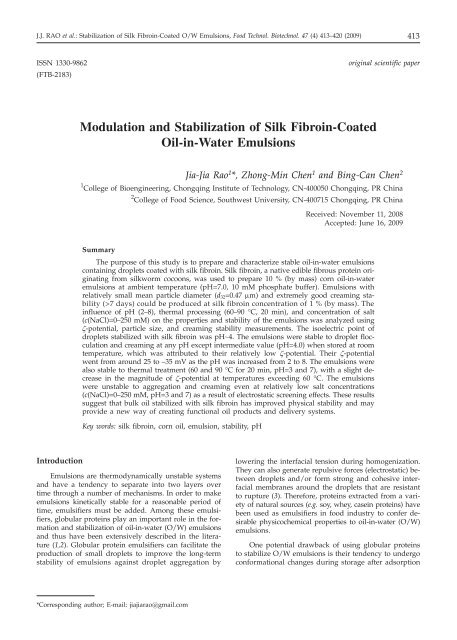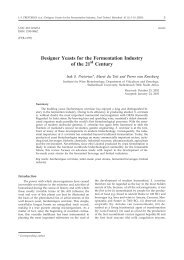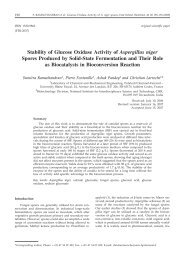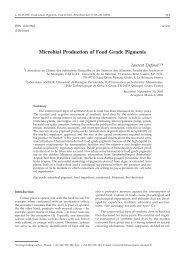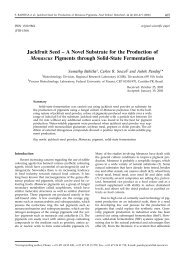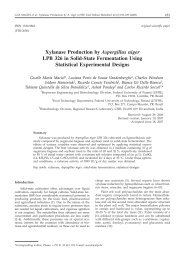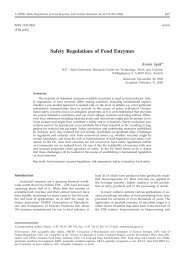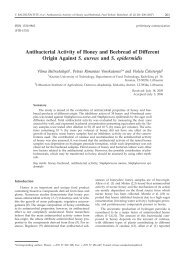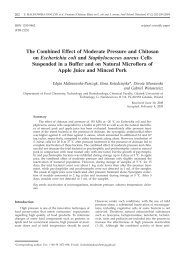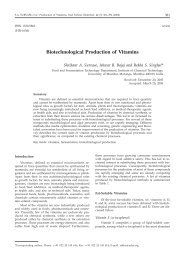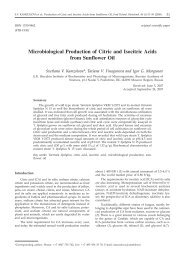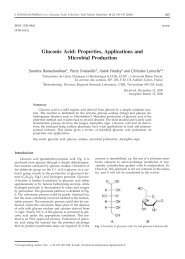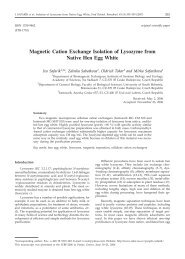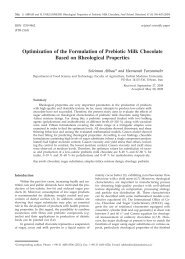Modulation and Stabilization of Silk Fibroin-Coated Oil-in-Water ...
Modulation and Stabilization of Silk Fibroin-Coated Oil-in-Water ...
Modulation and Stabilization of Silk Fibroin-Coated Oil-in-Water ...
You also want an ePaper? Increase the reach of your titles
YUMPU automatically turns print PDFs into web optimized ePapers that Google loves.
416 J.J. RAO et al.: <strong>Stabilization</strong> <strong>of</strong> <strong>Silk</strong> <strong>Fibro<strong>in</strong></strong>-<strong>Coated</strong> O/W Emulsions, Food Technol. Biotechnol. 47 (4) 413–420 (2009)Cream<strong>in</strong>g stability measurementA mass <strong>of</strong> 10 g <strong>of</strong> emulsions was transferred <strong>in</strong>to aglass test tube (<strong>in</strong>ternal diameter 15 mm, height 125 mm),tightly sealed with a plastic cap, <strong>and</strong> then stored at roomtemperature for 7 days. After storage, some <strong>of</strong> the emulsionswere separated <strong>in</strong>to a number <strong>of</strong> layers: a 'cream'layer at the top, a 'suspension' layer <strong>in</strong> the middle, <strong>and</strong> a'serum' layer at the bottom. These layers could be dist<strong>in</strong>guishedby their visual appearance: the cream layer wasoptically opaque <strong>and</strong> whiter than the orig<strong>in</strong>al emulsion,the suspension layer had the same appearance as the orig<strong>in</strong>alemulsion, <strong>and</strong> the serum layer was either slightlyturbid or transparent. The total height <strong>of</strong> the emulsion(H T ), the height <strong>of</strong> the serum layer (H SL ), <strong>and</strong> the height<strong>of</strong> the cream layer (H CL ) were measured. The extent <strong>of</strong>cream<strong>in</strong>g was characterized by cream<strong>in</strong>g <strong>in</strong>dices (CI),which were def<strong>in</strong>ed for the serum <strong>and</strong> cream layers respectively,as follows:CI SL =100·(H SL /H T ) /4/CI CL =100·(H CL /H T ) /5/The cream<strong>in</strong>g <strong>in</strong>dices provided <strong>in</strong>direct <strong>in</strong>formationabout the extent <strong>of</strong> droplet aggregation <strong>in</strong> an emulsion,for example, the higher the cream<strong>in</strong>g <strong>in</strong>dices, the greaterthe particle aggregation.Statistical analysisExperiments were performed at least twice us<strong>in</strong>gfreshly prepared samples. Average <strong>and</strong> st<strong>and</strong>ard deviationswere calculated from these duplicate measurements.Results <strong>and</strong> DiscussionOptimum conditions to form silkfibro<strong>in</strong>-coated dropletsThe purpose <strong>of</strong> these experiments was to establishthe optimum silk fibro<strong>in</strong> concentration required to formstable emulsions. The electrical charge (z-potential), particlesize distribution, cream<strong>in</strong>g stability, microstructure,amount <strong>of</strong> destabilized oil <strong>and</strong> mean particle diameter(d 32 ) <strong>of</strong> emulsions (10 % corn oil, by mass; 10 mM phosphatebuffer, pH=7.0) conta<strong>in</strong><strong>in</strong>g different silk fibro<strong>in</strong>mass fractions (0.2–3 %) were measured 24 h after preparation.The electrical charge <strong>of</strong> the emulsion droplets wasnegative at pH=7.0 because this pH was above the pI <strong>of</strong>the absorbed silk fibro<strong>in</strong>s. There was no significant change<strong>in</strong> z-potential with<strong>in</strong> the range <strong>of</strong> silk fibro<strong>in</strong> mass fraction(0.2–3.0 %), with the average be<strong>in</strong>g (–30.7±1.4) mV.S<strong>in</strong>ce the emulsion droplets are coated with a chargedbiopolymer, electrostatic repulsion is expected to play animportant role to prevent aggregation (13,14).The mean particle diameter (d 32 ) <strong>of</strong> emulsion decreasedas the mass fraction <strong>of</strong> silk fibro<strong>in</strong> <strong>in</strong>creasedfrom0.2to1%,itsm<strong>in</strong>imumbe<strong>in</strong>g(0.47±0.05) mm conta<strong>in</strong><strong>in</strong>g1 % (by mass) <strong>of</strong> silk fibro<strong>in</strong> (Fig. 1). The largeaggregates were observed under the microscope (d 32 >10mm), <strong>and</strong> rapid cream<strong>in</strong>g (CI CL >40 %) was observed <strong>in</strong>d 32 / m m3.53.02.52.01.51.00.50.00.00.50.2% 0.5% 1% 1.5%1.0 1.5 2.0 2.5w(silk fibro<strong>in</strong>)/%Fig. 1. Influence <strong>of</strong> silk fibro<strong>in</strong> mass fraction on the mean particlediameter (d 32 ) <strong>of</strong> corn oil-<strong>in</strong>-water emulsions. Inserted isthe morphology <strong>of</strong> relevant emulsions under microscope 400´;more sta<strong>in</strong><strong>in</strong>g means worse dispersionthe emulsions conta<strong>in</strong><strong>in</strong>g 0.2 <strong>and</strong> 0.5 % (by mass) <strong>of</strong> silkfibro<strong>in</strong>, whereas no aggregation or cream<strong>in</strong>g were observedat 1%(bymass)silk fibro<strong>in</strong>. These results can beattributed to the follow<strong>in</strong>g reasons: (i) the total dropletsurface area that can be stabilized by the <strong>in</strong>creased massfraction <strong>of</strong> silk fibro<strong>in</strong>; (ii) the rate at which the dropletsurfaces were covered with <strong>in</strong>creased mass fraction <strong>of</strong>silk fibro<strong>in</strong>; (iii) the frequency <strong>of</strong> droplet collisions decreaseddue to the <strong>in</strong>crease <strong>in</strong> aqueous phase viscosity.All <strong>of</strong> these factors should facilitate droplet disruption<strong>and</strong> prevent droplet coalescence with<strong>in</strong> the homogenizer,therefore lead<strong>in</strong>g to the formation <strong>of</strong> smaller droplet sizes.However, the mean particle diameter (d 32 ) <strong>of</strong> theemulsion <strong>in</strong>creased aga<strong>in</strong> when the mass fraction <strong>of</strong> silkfibro<strong>in</strong> was over 1.5 %. Apart from this, the foam wasobserved after homogeniz<strong>in</strong>g. Therefore, the foam capacity<strong>of</strong> the silk fibro<strong>in</strong> was measured (Fig. 2). There wasno foam capacity when the silk fibro<strong>in</strong> mass fractionwas very low (i.e. 0.2 or 0.5 %), after which it <strong>in</strong>creasedwith the <strong>in</strong>crease <strong>of</strong> silk fibro<strong>in</strong> mass fraction. The highestfoam capacity was 136 % at the silk fibro<strong>in</strong> mass fraction<strong>of</strong> 3 %. This observation suggests that higher silkfibro<strong>in</strong> mass fraction enhances foam<strong>in</strong>g capacity, whichcan be attributed to the above conclusion that the averageparticle diameter <strong>in</strong>creased with the higher silk fibro<strong>in</strong>mass fraction. In addition, oil destabilization mea-Foam capacity/%160140120100806040203.03.500.0 0.5 1.0 1.5 2.0 2.5 3.0 3.5w(silk fibro<strong>in</strong>)/%Fig. 2. Influence <strong>of</strong> silk fibro<strong>in</strong> mass fraction on the foam capacity<strong>of</strong> corn oil-<strong>in</strong>-water emulsions
J.J. RAO et al.: <strong>Stabilization</strong> <strong>of</strong> <strong>Silk</strong> <strong>Fibro<strong>in</strong></strong>-<strong>Coated</strong> O/W Emulsions, Food Technol. Biotechnol. 47 (4) 413–420 (2009)417surements (Fig. 3) confirmed that there was appreciable'oil<strong>in</strong>g-<strong>of</strong>f' <strong>in</strong> the emulsion with higher silk fibro<strong>in</strong> massfraction. At high silk fibro<strong>in</strong> mass fraction (³1.5 %), therewas more than 15 % <strong>of</strong> destabilized oil <strong>in</strong> the emulsions.All these results <strong>in</strong>dicate that O/W emulsions can be preparedus<strong>in</strong>g silk fibro<strong>in</strong> concentration. However, <strong>in</strong> orderto avoid the formation <strong>of</strong> foam dur<strong>in</strong>g homogeniz<strong>in</strong>g,1%(bymass)<strong>of</strong>silkfibro<strong>in</strong> was used to preparethe emulsion (i.e. silk fibro<strong>in</strong>-to-oil mass ratio <strong>of</strong> 1:10) <strong>in</strong>all subsequent experiments, because this mass fractionenabled the production <strong>of</strong> emulsions conta<strong>in</strong><strong>in</strong>g relativelysmall droplets that were stable to cream<strong>in</strong>g.Destabilized oil/%4030201000.0 0.5 1.0 1.5 2.0 2.5 3.0 3.5w(silk fibro<strong>in</strong>)/%Fig. 3. Influence <strong>of</strong> silk fibro<strong>in</strong> mass fraction on the amount <strong>of</strong>destabilized oil <strong>in</strong> 10 % (by mass) corn oil-<strong>in</strong>-water emulsionsSurface activity <strong>of</strong> silk fibro<strong>in</strong>The ability <strong>of</strong> prote<strong>in</strong> to form <strong>and</strong> stabilize emulsionsis dependent on their ability to adsorb to <strong>in</strong>terfaces<strong>and</strong> on the amount <strong>of</strong> prote<strong>in</strong> required to saturatethe <strong>in</strong>terface (15). The foam capacity is also dependenton it. In an attempt to expla<strong>in</strong> the emulsify<strong>in</strong>g ability<strong>and</strong> foam capacity <strong>of</strong> silk fibro<strong>in</strong>, the surface activity <strong>of</strong>silk fibro<strong>in</strong> was measured.The dependence <strong>of</strong> surface tension (g) <strong>of</strong> silk fibro<strong>in</strong>mass fraction <strong>in</strong> 10 mM phosphate buffer solution wastested (Fig. 4). As the silk fibro<strong>in</strong> mass fraction <strong>in</strong>creased,the surface tension decreased from 71.5 mN/m<strong>in</strong> the absence <strong>of</strong> silk fibro<strong>in</strong> to a constant value <strong>of</strong> 58.8g/(mN /m )807570656055500.0 0.5 1.0 1.5 2.0 2.5 3.0 3.5w(silk fibro<strong>in</strong>)/%Fig. 4. Influence <strong>of</strong> silk fibro<strong>in</strong> mass fraction on the surface tension<strong>of</strong> silk fibro<strong>in</strong> solutions at 30 °CmN/m when the <strong>in</strong>terface became saturated with silkfibro<strong>in</strong> <strong>of</strong> 1.5 %, then sharply dropped to 54.9 mN/mwith the cont<strong>in</strong>ued <strong>in</strong>crease <strong>in</strong> silk fibro<strong>in</strong> mass fractionto 3 %. The surface activity <strong>of</strong> silk fibro<strong>in</strong> was relativelylow when concentrations were lower. This can be attributedto its relatively high hydrophobic properties.Generation <strong>of</strong> foam <strong>in</strong>volves the development <strong>of</strong> aprote<strong>in</strong> film surround<strong>in</strong>g a gas bubble <strong>and</strong> the pack<strong>in</strong>g<strong>of</strong> gas bubbles <strong>in</strong>to an overall structure. The spontaneousadsorption <strong>of</strong> prote<strong>in</strong>s from the solution to theair/aqueous <strong>in</strong>terface is <strong>of</strong> central importance for theirfoam<strong>in</strong>g performance. This phenomenon is thermodynamicallyfavourable due to the simultaneous dehydration<strong>of</strong> the hydrophobic <strong>in</strong>terface <strong>and</strong> hydrophobic portions<strong>of</strong> the prote<strong>in</strong>. Hydrophobic patches on the surface <strong>of</strong> aprote<strong>in</strong> <strong>in</strong>itially drive this process, <strong>and</strong> surface hydrophobicityhas been correlated with improved foam<strong>in</strong>gproperties (16). Once contacts are made with the <strong>in</strong>terface,flexibility with<strong>in</strong> the molecules can expose previouslyburied hydrophobic portions <strong>in</strong>to the <strong>in</strong>terface,potentially lead<strong>in</strong>g to <strong>in</strong>terfacial denaturation <strong>of</strong> the molecules<strong>and</strong> subsequent reduction <strong>in</strong> surface tension (17).This has been correlated with improved foamability. Inorder to avoid its foamability dur<strong>in</strong>g emulsion process<strong>in</strong>g,silk fibro<strong>in</strong> mass fraction <strong>of</strong> 1%<strong>in</strong>theemulsionsystem was selected.Influence <strong>of</strong> pH on the emulsion stabilityThe <strong>in</strong>fluence <strong>of</strong> storage pH (2–8) on the droplet charge(z-potential), mean particle diameter (d 32 ), <strong>and</strong> cream<strong>in</strong>gstability <strong>of</strong> 10 % (by mass) <strong>of</strong> corn oil-<strong>in</strong>-water emulsionsstabilized with silk fibro<strong>in</strong> was measured (Figs. 5–7).z-potential/mV4020012 3 4 5 6 7 8 9-20-40-60Fig. 5. Influence <strong>of</strong> pH on z-potential <strong>of</strong> corn oil-<strong>in</strong>-water emulsionsstabilized with silk fibro<strong>in</strong> (1 %, by mass)d 32 / m m2.52.01.51.00.5pH0.01 2 3 4 5 6 7 8 9pHFig. 6. Influence <strong>of</strong> pH on the mean particle size <strong>of</strong> corn oil-<strong>in</strong>--water emulsions stabilized with silk fibro<strong>in</strong> (1 %, by mass)
418 J.J. RAO et al.: <strong>Stabilization</strong> <strong>of</strong> <strong>Silk</strong> <strong>Fibro<strong>in</strong></strong>-<strong>Coated</strong> O/W Emulsions, Food Technol. Biotechnol. 47 (4) 413–420 (2009)8060CI SLCI CL1.00.8pH=3pH=7CI/%4020d 32/ m m0.60.40.202 3 4 5pH6 7 8Fig. 7. Influence <strong>of</strong> pH on the cream stability <strong>of</strong> corn oil-<strong>in</strong>--water emulsions stabilized with silk fibro<strong>in</strong> (1 %, by mass). Insertedis the cream stability <strong>of</strong> emulsions at various pH, separationsignifies unstability0.0unheated60 90t/°CFig. 8. Influence <strong>of</strong> thermal process<strong>in</strong>g on the mean particle size<strong>of</strong> corn oil-<strong>in</strong>-water emulsions stabilized with silk fibro<strong>in</strong> (1 %,by mass)The z-potential was relatively high (25.7 mV) atpH=2.0, but it became less positive with <strong>in</strong>creas<strong>in</strong>g pHuntil it reached a value <strong>of</strong> zero at around pH=4.0, <strong>and</strong>then became <strong>in</strong>creas<strong>in</strong>gly negative as the pH <strong>in</strong>creasedfurther, until it reached a value <strong>of</strong> –35.4 mV at pH=8.0.The droplets <strong>in</strong> prote<strong>in</strong>-stabilized emulsions have zeronet charge around the isoelectric po<strong>in</strong>t (IEP) <strong>of</strong> the adsorbedprote<strong>in</strong>s. Our z-potential vs. pHmeasurementssuggested that the pI values <strong>of</strong> the silk fibro<strong>in</strong> werearound pH=4.0. This value is quite similar to the pIvalue reported by the other researchers (18).The mean particle diameter (d 32 ) rema<strong>in</strong>ed relativelysmall (
J.J. RAO et al.: <strong>Stabilization</strong> <strong>of</strong> <strong>Silk</strong> <strong>Fibro<strong>in</strong></strong>-<strong>Coated</strong> O/W Emulsions, Food Technol. Biotechnol. 47 (4) 413–420 (2009)419z-potential/mV201000 50 100 150 200 250-10-20-30-40pH=3pH=7c(NaCl)/mMFig. 10. Influence <strong>of</strong> NaCl on z-potential <strong>of</strong> corn oil-<strong>in</strong>-wateremulsions stabilized with silk fibro<strong>in</strong> (1 %, by mass)d 32 / m m54321pH=3pH=700 50 100 150 200 250c(NaCl)/mMFig. 11. Influence <strong>of</strong> NaCl on the mean particle size <strong>of</strong> corn oil--<strong>in</strong>-water emulsions stabilized with silk fibro<strong>in</strong> (1 %, by mass)with <strong>in</strong>creas<strong>in</strong>g NaCl concentration at pH=7.0 than atpH=3.0. The most likely reason for this difference is thatthe monovalent Na + ions are counterions for the anionicdroplets <strong>in</strong> the emulsion, whereas the monovalent Cl –ions are counterions for the cationic droplets <strong>in</strong> the emulsion.Also, the Na + ions are more sensitive to b<strong>in</strong>d<strong>in</strong>g tothe droplets coated with silk fibro<strong>in</strong> at pH=3.0. This wasalso confirmed by the mean droplet diameter (d 32 )measurements,which showed that the magnitude <strong>of</strong> d 32 <strong>in</strong>creaseat pH=7.0 was smaller than that at pH=3.0 with<strong>in</strong>creas<strong>in</strong>g NaCl concentration, presumably because electrostaticscreen<strong>in</strong>g <strong>and</strong> ion b<strong>in</strong>d<strong>in</strong>g effects reduced moreelectrostatic repulsion at pH=3.0 than at pH=7.0 betweenthe oil droplets. It was also found that the meanparticle diameters (d 32 ) at pH=3.0 <strong>and</strong> 7.0 sharply <strong>in</strong>creasedeven when 50 mM <strong>of</strong> sodium chloride were added.This would account for the fact that lower amount<strong>of</strong> NaCl was needed to promote droplet aggregation <strong>in</strong>the emulsion. The cream<strong>in</strong>g stability (data not shown) <strong>of</strong>emulsion was relatively high (CI SL >50 %) even at lowerconcentration <strong>of</strong> salt. All these results suggest that silkfibro<strong>in</strong>-stabilized emulsions were unstable aga<strong>in</strong>st dropletaggregation even at lower ionic strength, when electrostatic<strong>in</strong>teractions would be screened. Hence, it can beconcluded that polymeric steric repulsion plays a lessimportant role than electrostatic repulsion <strong>in</strong> prevent<strong>in</strong>gthe droplets from aggregat<strong>in</strong>g.ConclusionsThis study has shown that silk fibro<strong>in</strong>, which can beisolated from silkworm cocoon, is very effective <strong>in</strong> stabiliz<strong>in</strong>goil-<strong>in</strong>-water emulsion by absorb<strong>in</strong>g to the surface<strong>of</strong> lipid droplets. It has also helped to identify optimummass ratio <strong>of</strong> corn oil <strong>and</strong> silk fibro<strong>in</strong> (corn oil/silk fibro<strong>in</strong>=10:1)for the preparation <strong>of</strong> O/W emulsions. Theelectrical properties <strong>and</strong> aggregation stability <strong>of</strong> the silkfibro<strong>in</strong>-coated O/W emulsions were determ<strong>in</strong>ed as a function<strong>of</strong> pH, ionic strength, <strong>and</strong> thermal process<strong>in</strong>g becausethese environmental stresses are commonly encountered<strong>in</strong> the food <strong>in</strong>dustry. The silk fibro<strong>in</strong>-coatedO/W emulsions proved to be stable to aggregation at pHvalues sufficiently far from their isoelectric po<strong>in</strong>t (pH=4.0)at relatively low salt concentrations (
420 J.J. RAO et al.: <strong>Stabilization</strong> <strong>of</strong> <strong>Silk</strong> <strong>Fibro<strong>in</strong></strong>-<strong>Coated</strong> O/W Emulsions, Food Technol. Biotechnol. 47 (4) 413–420 (2009)8. A.S. Gob<strong>in</strong>, R. Rhea, R.A. Newman, A.B. Mathur, <strong>Silk</strong>--fibro<strong>in</strong>-coated liposomes for long-term <strong>and</strong> targeted drugdelivery, Int. J. Nanomedic<strong>in</strong>e, 1 (2006) 81–87.9. M. Lovett, C. Cannizzaro, L. Daheron, B. Messmer, G. Vunjak-Novakovic,D.L. Kaplan, <strong>Silk</strong> fibro<strong>in</strong> microtubes forblood vessel eng<strong>in</strong>eer<strong>in</strong>g, Biomaterials, 28 (2007) 5271–5279.10. X.Q. Wang, E. Wenk, A. Matsumoto, L. Me<strong>in</strong>el, C.M. Li,D.L. Kaplan, <strong>Silk</strong> microspheres for encapsulation <strong>and</strong> controlledrelease, J. Control. Release, 117 (2007) 360–370.11. J. Palanuwech, R. Pot<strong>in</strong>eni, R.F. Roberts, J.N. Coupl<strong>and</strong>, Amethod to determ<strong>in</strong>e free fat <strong>in</strong> emulsions, Food Hydrocolloids,17 (2003) 55–62.12. C.W. C<strong>of</strong>fman, V.V. Garcia, Functional properties <strong>and</strong> am<strong>in</strong>o--acid content <strong>of</strong> a prote<strong>in</strong> isolate from mung bean flour, J.Food. Technol. 12 (1977) 473–484.13. M.E. Leunissen, J. Zwanikken, R. van Roij, P.M. Chaik<strong>in</strong>,A. van Blaaderen, Ion partition<strong>in</strong>g at the oil-water <strong>in</strong>terfaceas a source <strong>of</strong> tunable electrostatic effects <strong>in</strong> emulsionswith colloids, Phys. Chem. Chem. Phys. 9 (2007) 6405–6414.14. J. Surh, E.A. Decker, D.J. McClements, Properties <strong>and</strong> stability<strong>of</strong> oil-<strong>in</strong>-water emulsions stabilized by fish gelat<strong>in</strong>,Food Hydrocolloids, 20 (2006) 596–606.15. O. Lawal, M. Dawodu, Maleic anhydride derivatives <strong>of</strong> aprote<strong>in</strong> isolate: Preparation <strong>and</strong> functional evaluation, Eur.Food. Res. Technol. 226 (2007) 187–198.16. H.Y. Sung, H.J. Chen, T.Y. Liu, J.C. Su, Improvement <strong>of</strong> thefunctionalities <strong>of</strong> soy prote<strong>in</strong> isolate through chemicalphosphorylation, J. Food Sci. 48 (1983) 716–721.17. J.R. Wagner, J. Guéguen, Surface functional properties <strong>of</strong>native, acid-treated, <strong>and</strong> reduced soy glyc<strong>in</strong><strong>in</strong>. 1. Foam<strong>in</strong>gproperties, J. Agric. Food. Chem. 47 (1999) 2173–2180.18. S. Tcholakova, N.D. Denkov, D. Sidzhakova, B. Campbell,Effect <strong>of</strong> thermal treatment, ionic strength, <strong>and</strong> pH on theshort-term <strong>and</strong> long-term coalescence stability <strong>of</strong> b-lactoglobul<strong>in</strong>emulsions, Langmuir, 22 (2006) 6042–6052.
FTB 47 (4) 413-420.(FTB-2183)Moduliranje i stabilizacija emulzija ulja u vodi pomoću fibro<strong>in</strong>a svileSažetakSvrha je ovoga rada bila pripremiti i okarakterizirati stabilnu emulziju ulja u vodi,koja sadrži kapljice obložene fibro<strong>in</strong>om svile. <strong>Fibro<strong>in</strong></strong> svile, prirodni jestivi vlaknasti prote<strong>in</strong>dobiven iz čahura dudova svilca, upotrijebljen je za pripremu emulzije kukuruznog ulja uvodi (masenog udjela od 10 %) na sobnoj temperaturi (pH=7, 10 mM fosfatni pufer).Primjenom fibro<strong>in</strong>a svile masene koncentracije od 1 % dobivene su emulzije relativno malogpromjera čestica (d 32 =0,47 µm) i vrlo dobre stabilnosti (dulje od 7 dana). Ispitan je utjecajpH-vrijednosti (pH=2–8), topl<strong>in</strong>ske obrade (60–90 °C, 20 m<strong>in</strong>) i koncentracije soli(c(NaCl)=0–250 mM) na svojstva i stabilnost emulzije (ζ-potencijal, velič<strong>in</strong>a čestica iraslojavanje emulzije). Izoelektrična točka kapljica stabiliziranih pomoću fibro<strong>in</strong>a svilepostignuta je pri pH~4. Emulzije skladištene na sobnoj temperaturi bile su stabilne pri svimpH-vrijednostima, osim pri srednjoj (pH=4,0) kada su imale relativno nizak ζ-potencijal.Povećanjem pH-vrijednosti s 2 na 8 povećao se ζ-potencijal emulzija (s 25 na -35 mV).Uočena je stabilnost emulzija i nakon topl<strong>in</strong>ske obrade (tijekom 20 m<strong>in</strong>uta na 60 i 90 °C, pripH=3 i 7), a pri temperaturama višim od 60 °C ζ-potencijal se neznatno smanjio. Zbog uč<strong>in</strong>kaelektrostatskog odbijanja emulzije su bile nestabilne čak i pri neznatnim koncentracijama soli(c(NaCl)=0-250 mM, pH=3 i 7). Rezultati upućuju na to da stabilizacija emulzija pomoćufibro<strong>in</strong>a svile omogućuje proizvodnju funkcionalnih proizvoda na bazi ulja.Ključne riječi: fibro<strong>in</strong> svile, kukuruzno ulje, emulzija, stabilnost, pH


